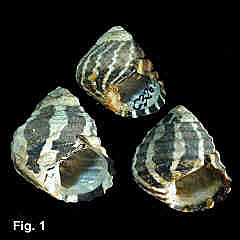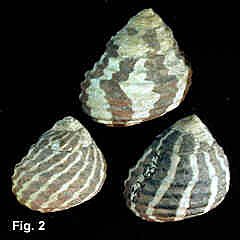

|
Austrocochlea
porcata (Adams,
1851)
Description:
Shell solid, heavy, relatively (in comparison with A. constricta) weakly
spirally ribbed, with 3-4 ribs on the penultimate whorl and 8-12 on the
body whorl. Aperture heavily ribbed internally, porcelain-white,
overlaying a nacreous layer, the edge of which can be seen on the outer
lip. External coloration white, with diagonal black or reddish-brown
stripes. Columella smooth, with a weak tooth at anterior end. Umbilicus
closed.
This
species is extremely variable. The colour pattern varies in the number,
width, and angle of the stripes, the apertural lirae may be strong or
obsolete, and the columellar tooth may be absent.
Size:
Average 25 mm, maximum 43 mm high.
Distribution:
Endemic to Australia; Whitsunday Passage, Qld, to Houtman Abrolhos, WA,
including Tas.
Habitat:
Lives exposed in a wide range of habitats from exposed rocky shores to
sand, seagrass and mangroves in sheltered estuaries, around the mid-tide
zone; abundant.
Comparison:
This species is very similar to Austrocochlea constricta. The
following table showing the differences between the two species is
slightly modified from that given by Parsons and Ward (1994) for four
populations they examined from southern Tasmania and one population from
southern NSW. More populations needs to be examined to be sure that
these difference apply over the ranges of the species on mainland
Australia.
| Character |
A.
porcata |
A.
constricta |
| Spiral ribs |
Weakly
spirally ribbed, 3-4 ribs on penultimate whorl, 8-12 on body
whorl |
Pronounced
shell ribbing, 2-3 ribs on penultimate whorl, 6-8 on body whorl |
| Shell colour
and pattern |
Longitudinally
striped on the spire and last whorl with parallel, alternate
bands of off-white and black to red; intensity of banding
pigmentation uniform over the shell surface |
Shell
unicoloured, off white, or weakly striped |
| Snout |
Orange
stripe on black snout |
Black, no
stripe |
| Cephalic
lappets |
Green/orange,
frondose, positioned anteriorly on the head |
Black,
solid, positioned at the sides of the head |
| Mantle fringe |
Black |
Cream |
Remarks:
Creese & Underwood (1976a, 1976b) have investigated the ecology and
mechanisms responsible for colour banding in this species. They
investigated population densities, size class distributions, growth
rates, and variations in banding patterns at six sites near Sydney. They
report the food to be diatoms and algal spores scraped from the rock
surface, and the colour banding to be due to the pigment uroporphyrin I,
laid down by groups of cells at the edge of the mantle. Shell
colouration was determined to be an environmental, not a genetic factor;
heavily pigmented individuals from Mona Vale, grown in cages at Warumbul
showed a less dense pigmentation pattern when they laid down new shell.
Quantitative measurement of the amount of pigment in the shell and the
amount of chlorophyll in the substrate showed a linear relationship. The
amount of dark banding in the shell is proportional to the amount of
chlorophyll present in the food supply.
The
animal is described and figured by Hedley (1917).
Figs.
1,2: Bondi, Sydney, NSW (C.326312)
|